Intelligence Briefing - PRC ‘Maritime Militia’ clusters in the Spratly Islands
By Sean Thorne
Summary
On December 4th, 2023, the Philippine Coast Guard announced the deployment of two patrol vessels to the area of Whitsun Reef (called Juan Filippe Reef by the Philippines), located in the South China Sea, in response to its claim that approximately 135 People’s Republic of China (PRC) maritime militia vessels have amassed throughout the vicinity. The Philippines considers the reef to be part of its Exclusive Economic Zone, while the PRC views the island as part of its broader claim to vast swaths of the South China Sea. This brief aims to understand the scope of current Maritime Militia operations by estimating the locations and number of vessels currently undertaking operations around the Spratly Islands.
Recent Developments
This most recent spat follows two weeks of heightened tension between the PRC, the Philippines, and the United States in the region. The Philippines recently conducted joint maritime patrols with the United States in the area from November 21 to 23, and with Australia from November 25 to 27. On December 4, Beijing also voiced its opposition to the transiting of the USS Gabrielle Giffords, a U.S. Navy Littoral Combat Ship, in close proximity to Second Thomas Shoal. The shoal is part of the Spratly Islands, an area of the South China Sea, 105 nautical miles west of the Philippine province of Palawan. The reef is claimed by the Philippines, PRC, Taiwan, and Vietnam, though is under the administration of Manila. Notably, Second Thomas Shoal is home to the BRP Sierra Madre, a Philippine landing ship deliberately grounded on the reef in 1999 to function as an outpost of the Philippine Marine Corps and strengthen their sovereignty claim to the island.
The current swarm is centred around Whitsun Reef, an island in the northeast of Union Banks, in the centre of the Spratlys. Whitsun Reef, though claimed by the Philippines, PRC, Taiwan, and Vietnam, currently does not house any permanent structures - unlike many of the militarised islands in the region. While current traffic volumes are in line with historical trends, the current emphasis on Whitsun Reef underscores the island’s position as a strategic objective for both the PRC and the Philippines.
China’s Maritime Militia
Overview
The PRC is increasingly-assertive over its territorial claims in the South China Sea, and employs both conventional and non-conventional maritime assets in the region to consolidate its position. In addition to militarised vessels such as those of the People’s Liberation Army Navy (PLAN) and China Coast Guard (CCG), Beijing loosely controls a large fleet of Maritime Militia vessels. This established command structure tasks civilian-owned fishing vessels with loitering in the vicinity of disputed islands and chasing Philippine vessels conducting resupply missions in the area, in addition to regular fishing activities. The aim of this force structure is to strengthen PRC territorial claims in the region with a large, assertive, and visible strategic posture. This example of greyzone naval warfare tactics allow Beijing to strengthen its position while still avoiding the direct involvement of its regular maritime warfare branches, the PLAN and the CCG. Vietnam also operates a Maritime Militia, though on a much smaller scale regarding both fleet and vessel size, and this brief focuses on the Chinese fleet.
Vessel Characteristics and Identification
This brief identifies PRC Maritime Militia vessels through their recognizable features that allow them to be discerned through satellite imagery or using Automatic Identification System (AIS) tools. These specific indicators informed the deductions in ship traffic volume substantiated below.
Visual Indicators
Maritime Militia vessels range from 45 - 65 metres in length. This is noticeably larger than the maritime fleets of regional competitors while remaining smaller than People’s Liberation Army Navy and China Coast Guard assets.
The vessels are often painted in a recognisable colour scheme, with a blue hull and white superstructure (the part of a vessel includes above-deck features such as the bridge or wheelhouse). Many of these vessels also have red deck-level features, such as railings and cranes.
Vessel traffic surrounding a confirmed PRC Maritime Militia AIS target is unlikely to be a non-Chinese vessel. Given that engagements between Chinese and non-Chinese vessels can devolve into ramming and water cannon use, local traffic largely clusters depending on the flag a vessel sails under.
A significant portion of Maritime Militia vessels fall under one of three typical classes, each with distinguishable characteristics in their superstructures, and which correlate to their registration numbers - which are available for all AIS-tracked vessels:
Maritime Militia vessel recognition and identification. United States Office of Naval Intelligence.
AIS Indicators
The positive identification of Maritime Militia vessels on available Automatic Identification System (AIS) can be confirmed through its name, registration numbers, and navigational tracks - each discernable from real-time ship traffic information.
The naming format of Maritime Militia vessels is most often structured as the name Qiongsanshayu followed by a registration number, and is the clearest positive identification of a fleet vessel:
Qiong identifies a vessel as falling under the jurisdiction of Hainan Province.
Sansha identifies a vessel as being homeported in Sansha City.
Yu identifies a fishing vessel.
Each registration number subsequently corresponds to the three classes of Militia boats illustrated above:

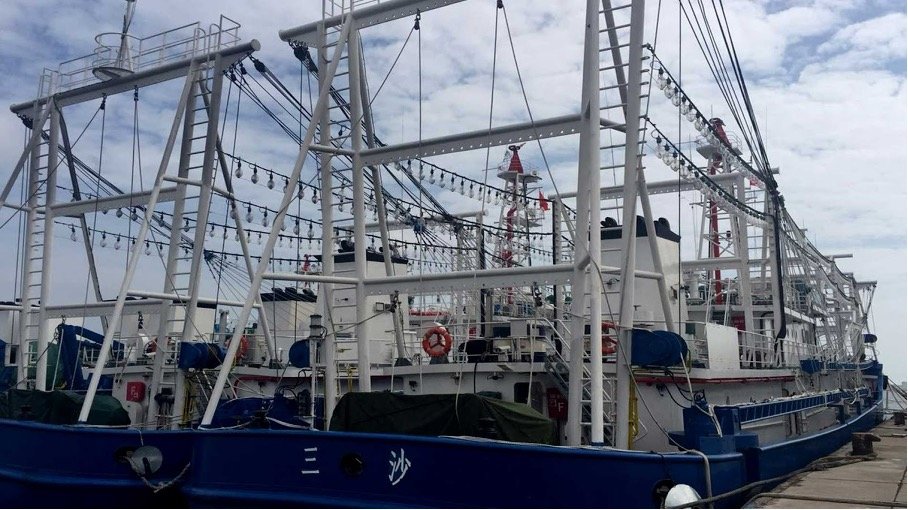
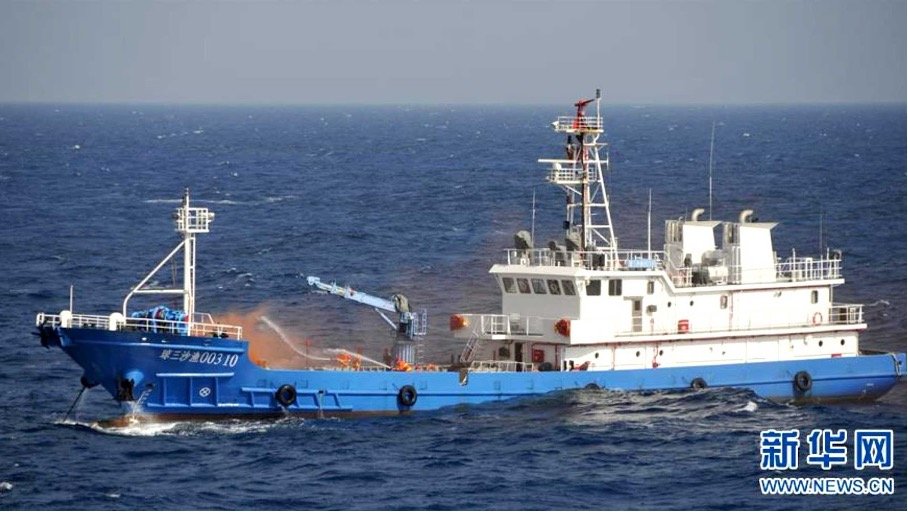
The majority of vessels identified as part of the Maritime Militia originate from Sansha City, Hainan Province, and operate out of six main ports in Hainan and Guangdong Provinces. AIS tracks characterise the vessels as undertaking regular transits from to varying locations within the Spratly Islands and the broader South China Sea. Similar track patterns are present among each of the PRC-flagged AIS vessels mapped on the subsequent marine charts.
Example AIS tracks of Maritime Militia vessel Qiong Sansha Yu 313, September 8, 2020 to December 4, 2023. MarineTraffic.
Current Clusters
This brief identifies seven clusters of Maritime Militia vessel currently positioned across the Spratly Islands, as of December 4, 2023:
Union Banks - the location of recent tensions between the Philippines and China;
Whitsun Reef
Hughes Reef
Johnson South Shoal
Second Thomas Shoal;
Mischief Reef;
Tizard Bank;
Subi Reef;
Thitu Reefs;
Fiery Cross Reef.
The Spratly Islands. MarineTraffic.
This brief aims to corroborate the positioning data of the vessels that use AIS with satellite imagery taken between December 2 and December 4, 2023, in order to approximate the number of Maritime Militia vessels currently operating in the Spratly Islands. Counts are deduced from the maximum number of vessels identified in a given area, whether through AIS or clear visibility in satellite imagery. Given the small fraction of militia vessels that regularly use AIS and the inability to confirm individual vessels from satellite imagery alone, the reported tallies are an estimation of fleet strength.
Union Banks
Union Banks AIS Targets. 04:30 UTC December 5, 2023. MarineTraffic.
AIS Targets in the Union Banks area indicate six vessels from the Sansha City militia, two additional Chinese Maritime Militia vessels and a Vietnamese vessel. Subsequent satellite imagery subdivides this area into 1) Whitsun Reef, 2) Hughes Reef, and 3) Johnson South Reef.
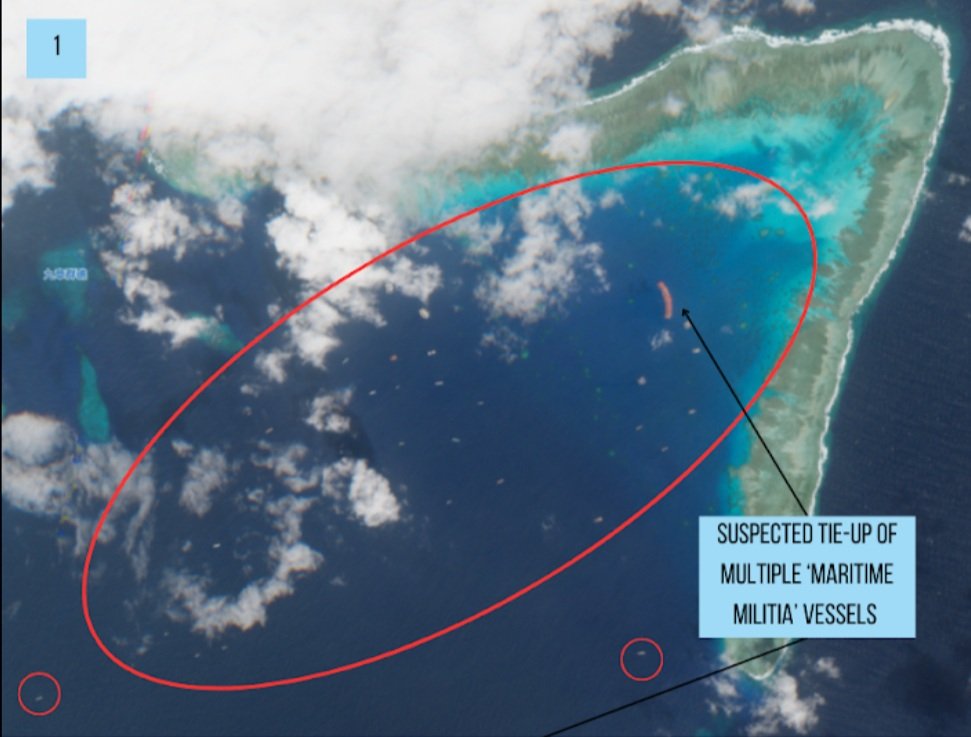
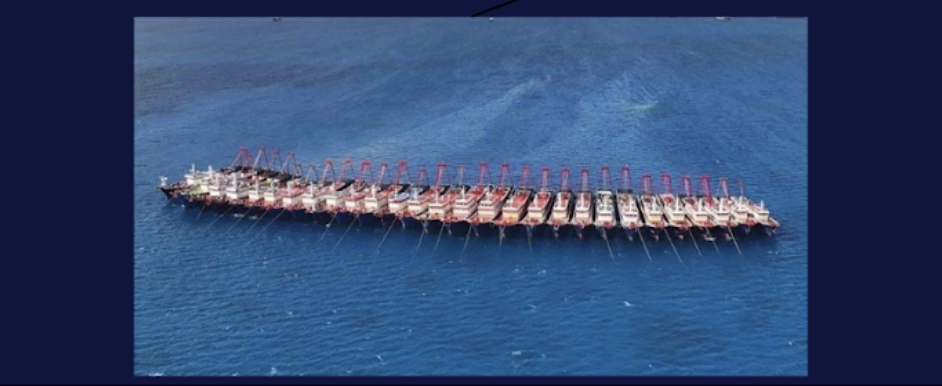
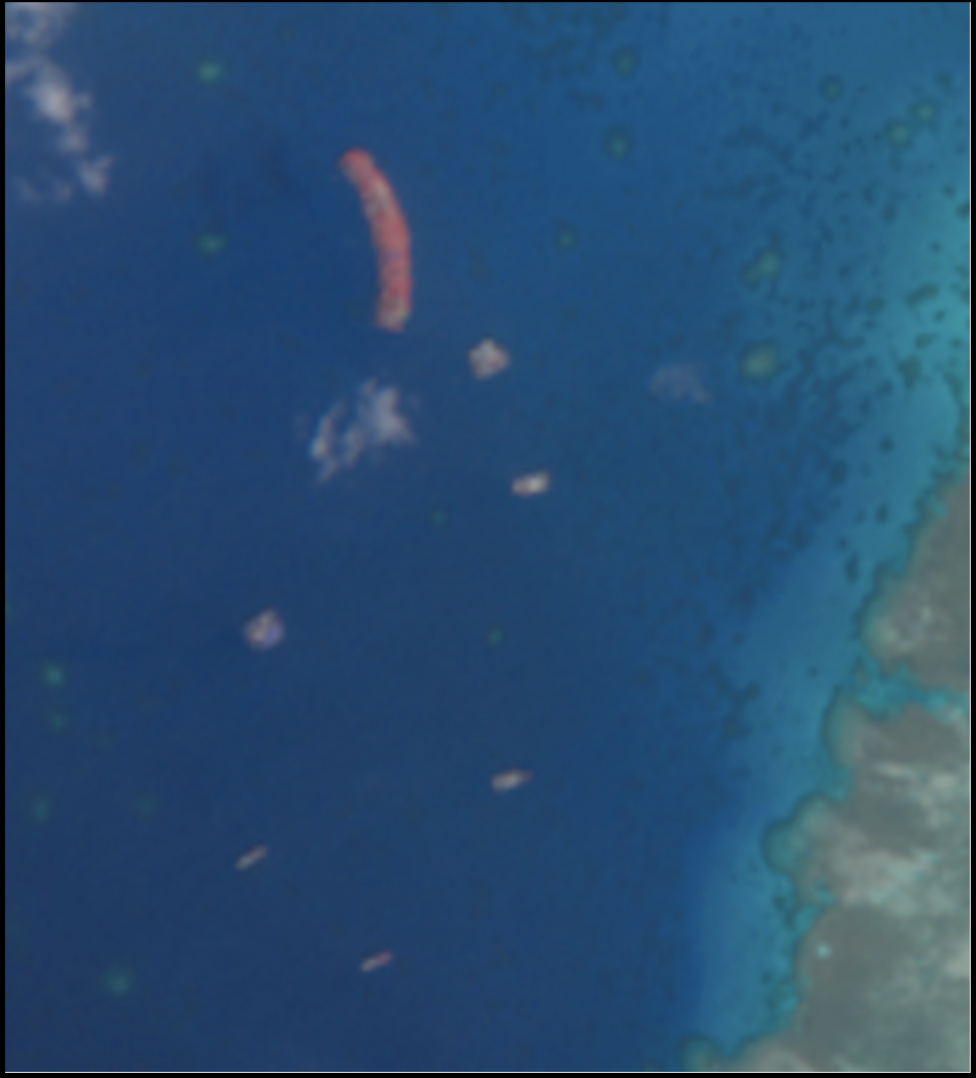
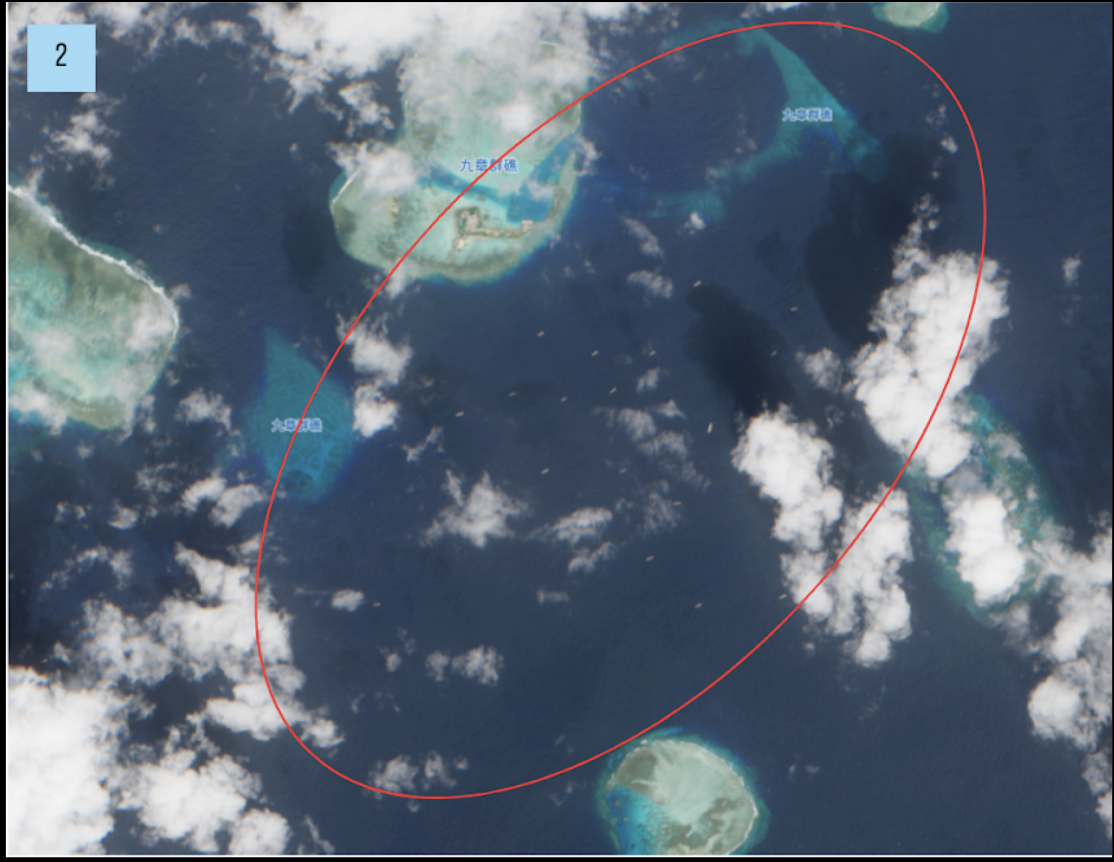
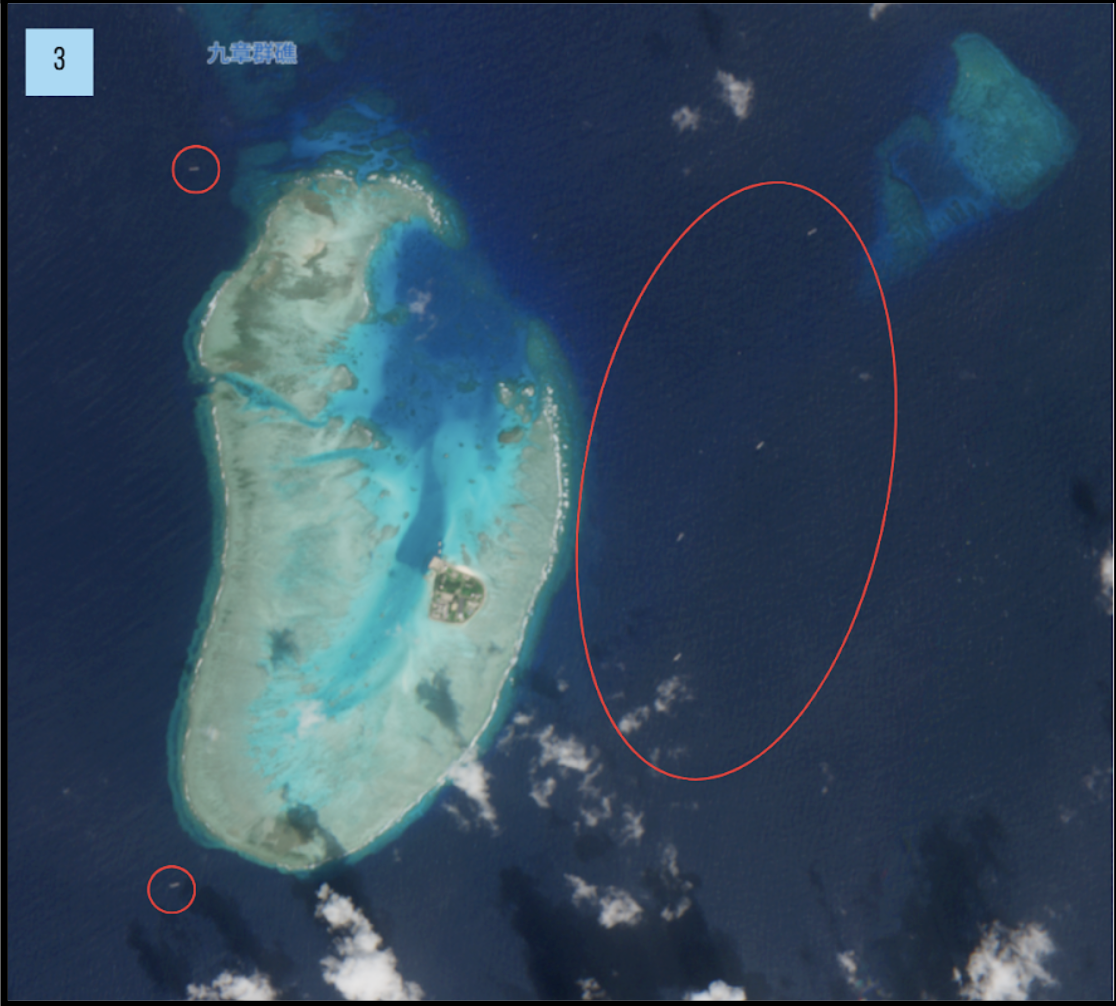
1. Whitsun Reef (unadministered) (see above Imagery 1,2,3)
Satellite imagery for Whitsun Reef indicates no less than 26 individual vessels operating in the atoll. Additionally, a suspected tie-up is visible in the top-right of the cluster, with reference photo above. The total number of vessels in the vicinity of Whitsun Reef is estimated to be approximately 32.
2. Hughes Reef (PRC-administered) (see above Imagery 4)
Satellite imagery for Hughes Reef indicates no less than 16 vessels operating south of the island.
3. Johnson South Reef (PRC-administered) (see above Imagery 5)
Satellite imagery for Johnson South Reef indicates no less than four vessels to the east of the landmass, with an additional vessel off the northwest and southwest corners respectively, for a total of six.
The estimated total of Maritime Militia vessels currently operating in the area of Union Banks is no less than 54.
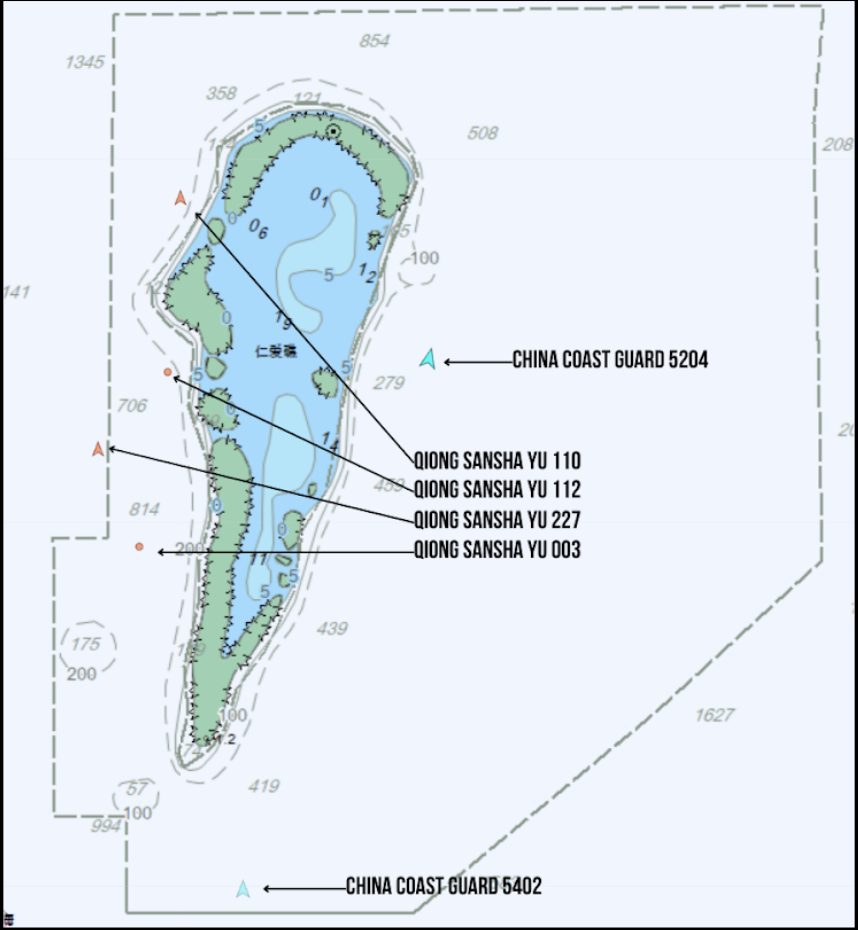

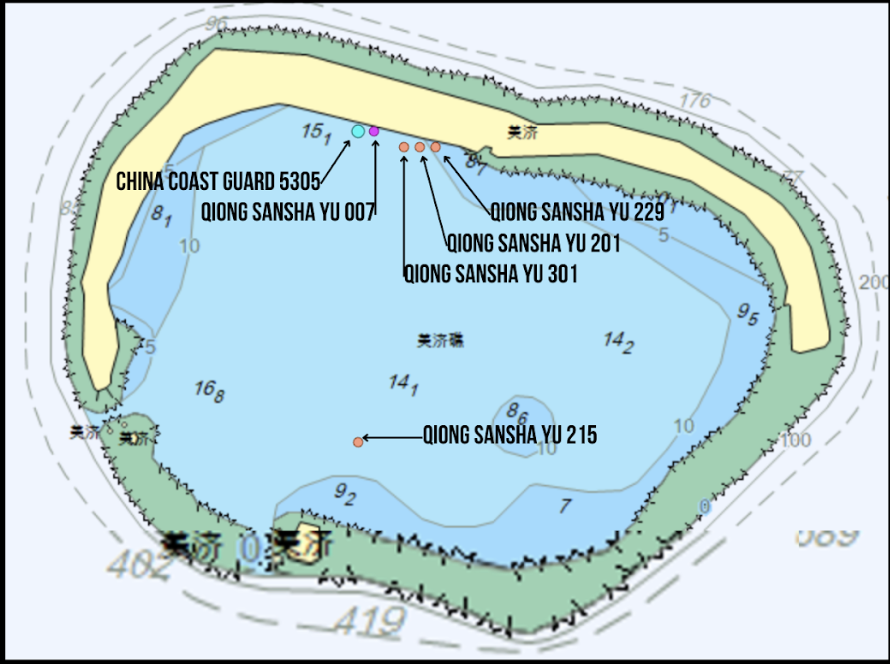
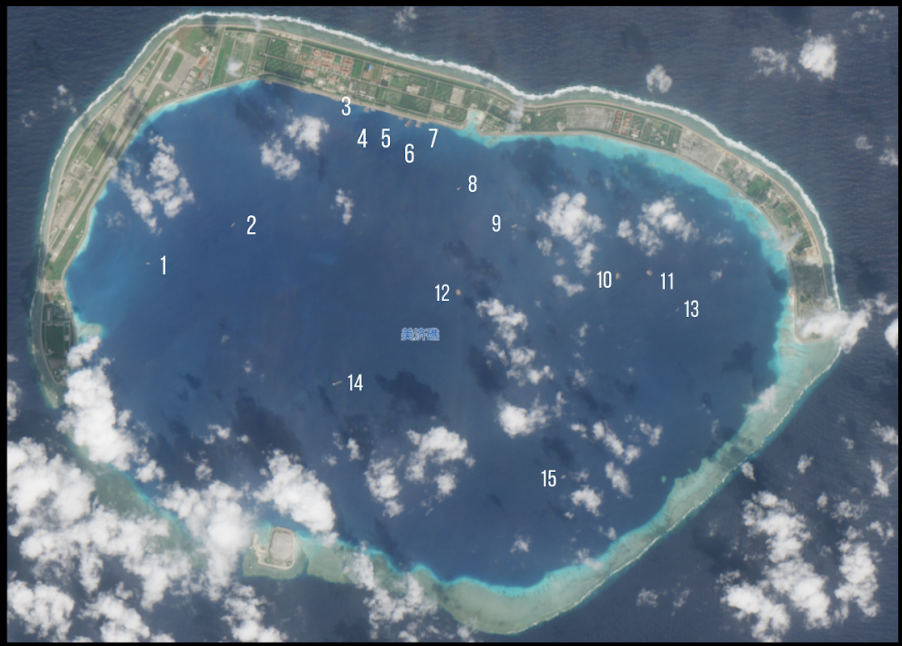
Second Thomas Shoal (Philippines-administered) (see above Imagery 1,2)
AIS targets in the area indicate four Maritime Militia vessels to the west of Second Thomas Shoal, and a China Coast Guard vessel to the east.
Satellite imagery for Second Thomas Shoal confirms no less than two vessels operating to the east of the reef.
The estimated total of Maritime Militia vessels currently operating in the area of Second Thomas Shoal is no less than four, China Coast Guard excluded.
Mischief Reef (PRC-administered) (see above Imagery 3,4)
AIS targets in the area indicate five Maritime Militia vessels and one China Coast Guard vessel at Mischief Reef.
Satellite imagery for Mischief Reef indicates no less than 15 vessels operating within the reef, less one China Coast Guard vessel shown on AIS.
The estimated total of Maritime Militia vessels currently operating in the area of Mischief Reef is no less than 14.
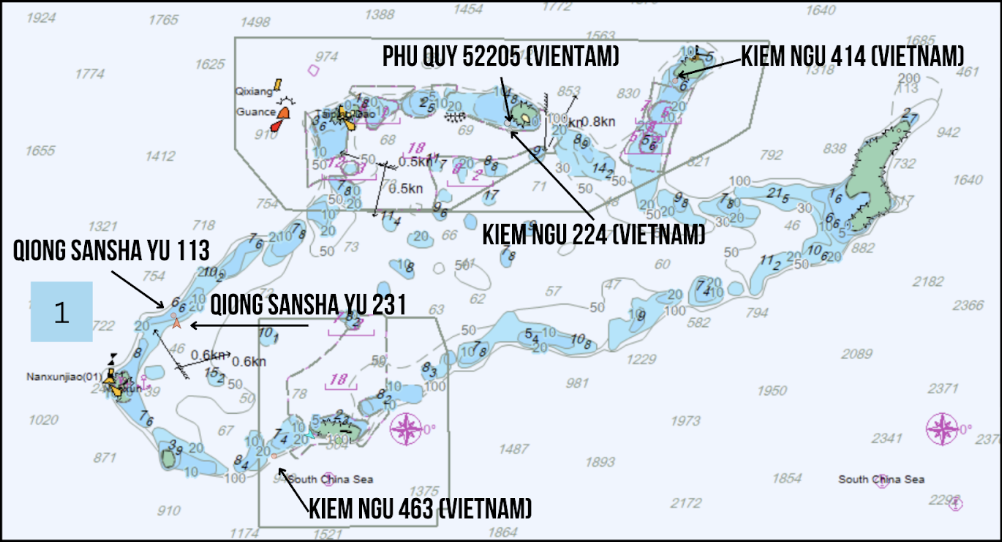
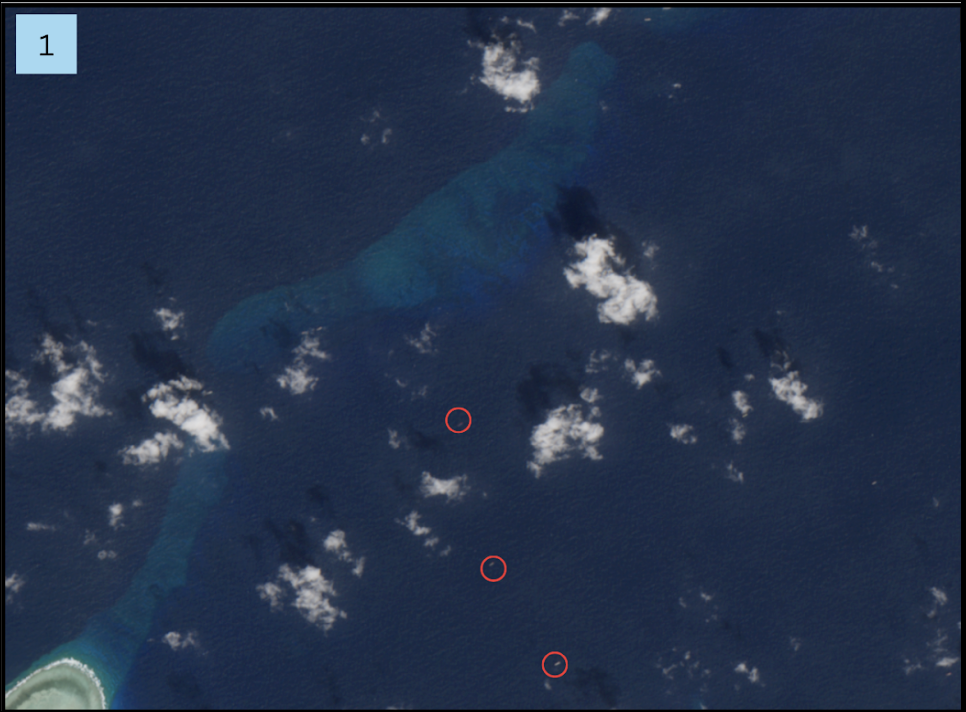
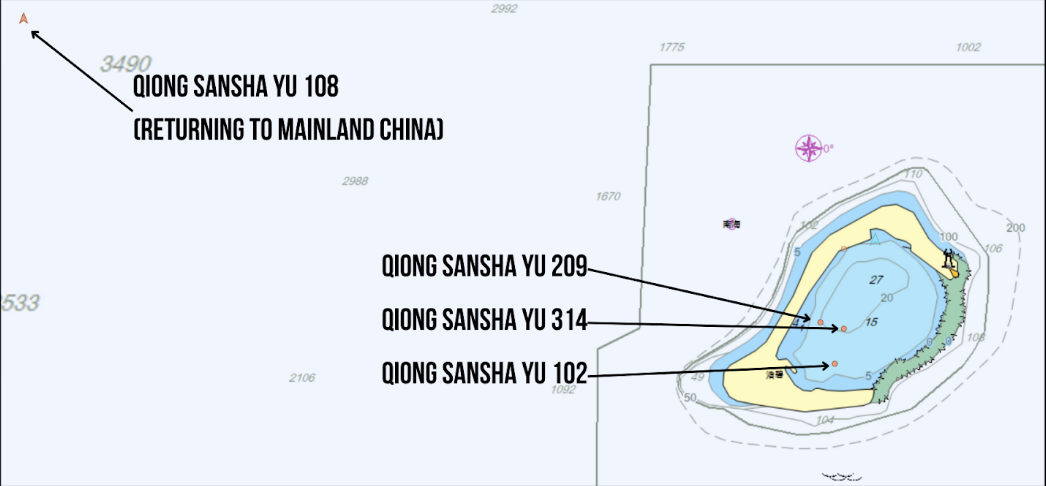
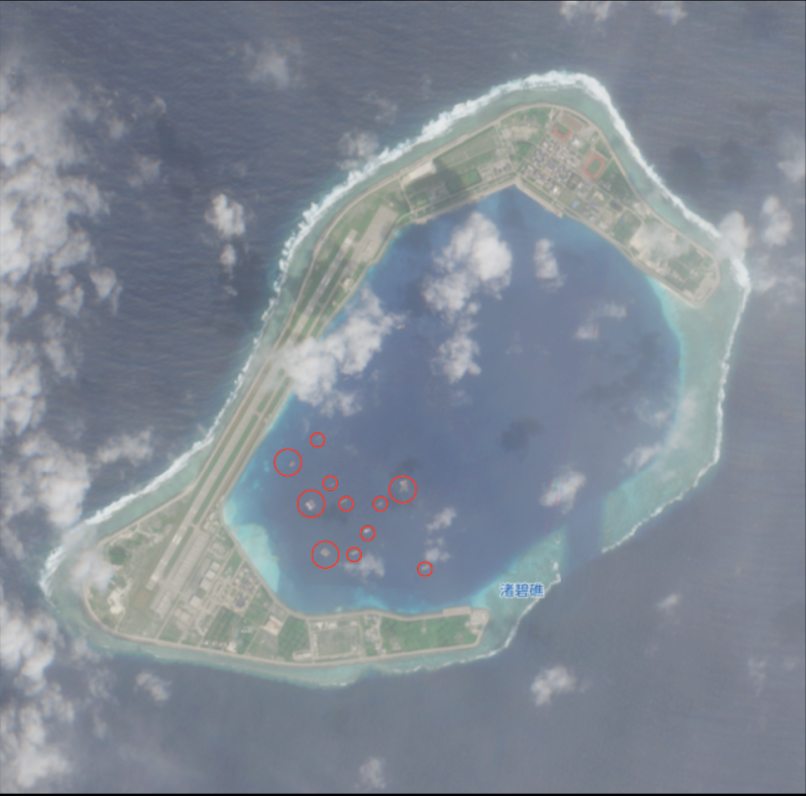
Tizard Bank (Gaven Reef / Eldad Reef PRC-administered, Namyit Island / Sand Cay / Petley Reef Vietnam-administered, Itu Aba Island / Zhongzhou Reef Taiwan-administered) (see above Imagery 1,2)
AIS targets in the area indicate two Maritime Militia vessels operating in the west of Tizard Bank around 1) Gaven Reefs, as well as three Vietnamese fisheries patrol vessels (Kiem Ngu), and an additional Vietnamese vessel.
Satellite imagery for Tizard Bank indicates three vessels operating in the vicinity of the Maritime Militia AIS targets noted above. Given their proximity to one another, it is reasonable to conclude that all three are Maritime Militia.
The estimated total of Maritime Militia vessels currently operating in the area of Tizard Bank is no less than three.
Subi Reef (PRC-administered) (see above Imagery 3,4)
AIS targets in the area indicate three Maritime Militia vessels operating within Subi Reef and a fourth transiting north, likely returning to Mainland China.
Satellite imagery for Subi Reef confirms approximately seven individual vessels (smaller circles), and four tie-ups of no less than two vessels (larger circles). Estimating each tie-up consists of two vessels, it is estimated that 15 vessels are currently operating within Subi Reef.
The estimated total of Maritime Militia vessels currently operating in the area of Subi Reef is no less than 15.

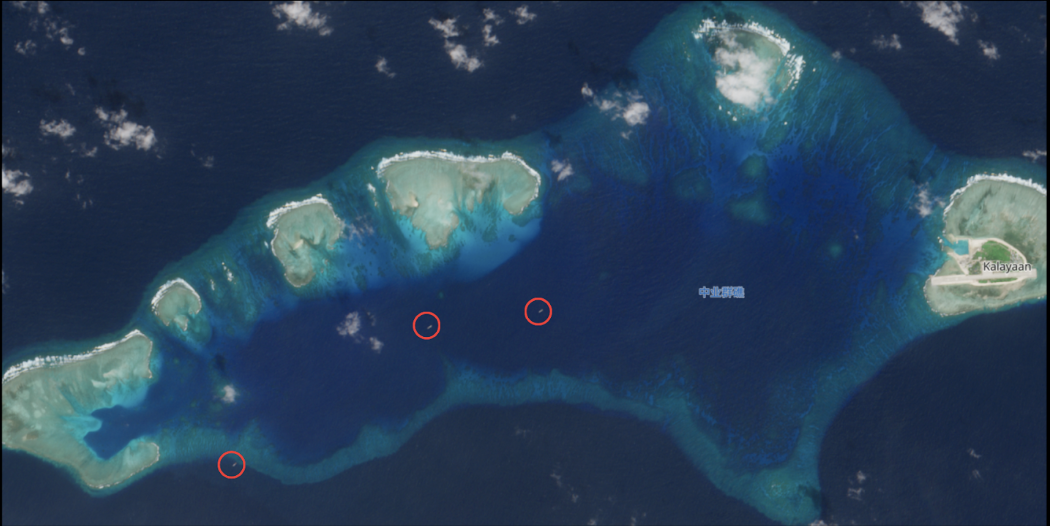
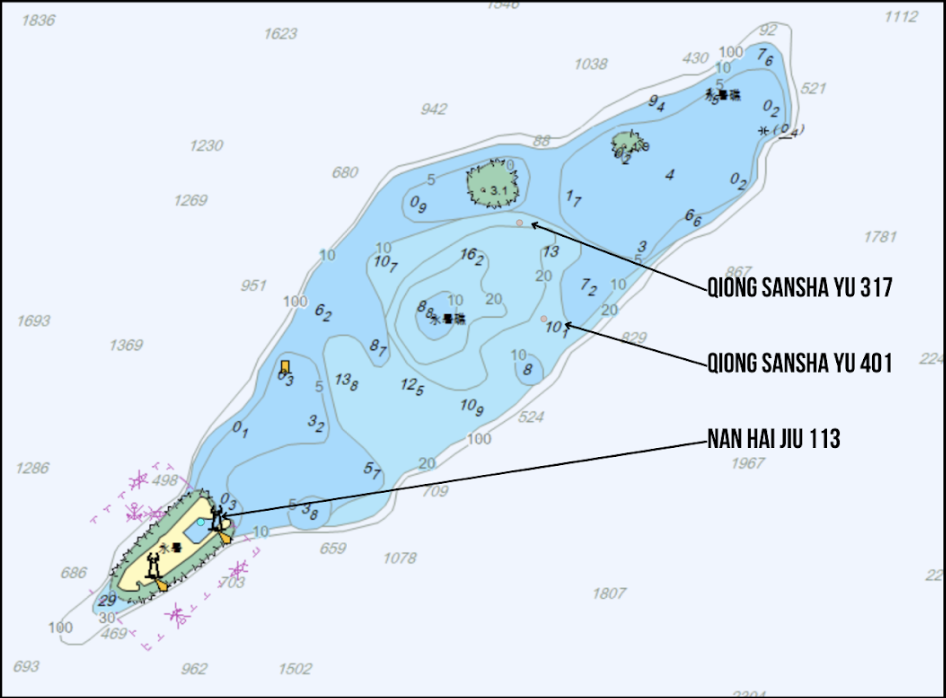
Thitu Reefs (Philippine-administered) (see above Imagery 1,2)
AIS targets in the area indicate three Sansha City Maritime Militia vessels operating south of Thitu Reefs, with an additional three Chinese Maritime Militia vessels.
Satellite imagery for Thitu Reefs confirms approximately three vessels.
The estimated total of Maritime Militia vessels currently operating in the area of Thitu Reefs is no less than six.
Fiery Cross Reef (PRC-administered) (see above Imagery 3)
AIS targets in the area indicate two Sansha City Maritime Militia vessels and one additional Chinese Maritime Militia vessel operating at Fiery Cross Reef.
The estimated total of Maritime Militia vessels currently operating in the area of Fiery Cross Reef is no less than three. Note: satellite imagery in the area of Fiery Cross Reef is obscured by clouds between December 2 and December 4, 2023.
Analysis
Overall, it is estimated there are no less than approximately 99 Maritime Militia vessels currently operating in the vicinity of the Spratly Islands, as of December 4, 2023. 54 of these are indicated to be directly proximal to Whitsun Reef, where the Philippines has accused China of swarming, though this report cannot verify the 135 number stated by the Philippine Coast Guard. Nonetheless, the figures reflect a consistent PRC pressure in the region to assert its claims to territories disputed with other regional actors. Though the volume of Maritime Militia has risen since November, the estimated total of operational vessels still aligns with historical trends in Maritime Militia deployment.
Particularly noteworthy is the consolidation of Marine Militia vessels in the area of Whitsun Reef. Of the main islands detailed in this brief, Whitsun is the only one without clear administration or physical structures built by the PRC, Vietnam, or Taiwan. While the current mass of vessels does not exceed a March 2021 dispute, during which over 200 PRC vessels moored off the reef, the current growth in maritime traffic is indicative of PRC intentions to consolidate its hold over Whitsun Reef itself and the broader Union Banks. Continued monitoring will determine whether this most recent episode will precede concrete - i.e. physical - developments in the area.
In just one week since the collection of the above data, from December 9 to 11, Chinese and Philippine standoffs have escalated in the vicinity of Scarborough and Second Thomas Shoals. On Monday, December 11, Assistant Director General of the Philippine National Security Council Jonathan Malaya accused China Coast Guard and Maritime Militia vessels of conducting dangerous manoeuvres against Philippine boats resupplying the BRP Sierra Madre, including the deployment of water cannons and collisions between PRC- and Philippine-flagged vessels. On board, one of the Philippine vessels impacted by the most recent spat was Chief of Staff of the Armed Forces of the Philippines (AFP) General Romeo Brawner Jr, the Philippines highest-ranked military officer.
Reacting to the escalation, U.S. Ambassador to the Philippines MaryKay Carlson condemned PRC actions as illegal and aggressive, while the U.S. State Department released a statement on December 10 reaffirming U.S. commitment to the 1951 U.S.-Philippines Mutual Defense Treaty. The statement further elaborated on Washington’s perspective that attacks on Philippine vessels anywhere in the South China Sea fall under article IV of the treaty - clearly signalling U.S. support for the Philippines and indicating a consolidated foreign policy position against PRC actions in the disputed region. Conversely, the China Coast Guard characterised the Philippine presence around Ren’ai Reef (its terminology for Second Thomas Shoal) as illegal, and stating that its actions in the vicinity of Scarborough Shoal constituted ‘legal control measures.’
Forecast
This most recent incident is likely to further entrench respective Chinese, Philippine, and U.S. positions in the region. On December 11, AFP Chief of Staff Gen. Romeo Brawner Jr. and U.S. Chairman of the Joint Chiefs of Staff General Charles Q. Brown Jr. affirmed their intention to deepen military cooperation between Philippine and U.S. forces. Philippine President Ferdinand “Bongbong” Marcos Jr. stated that PRC actions have strengthened Manila’s resolve in protecting its sovereignty claims while earlier on December 1, Chinese President Xi Jinping directed the China Coast Guard to better defend its territorial claims and maritime rights.
The Philippines and the United States drawing closer in their strategic relationship is a recent culmination of an ongoing courtship between the two allies. In 2023 alone, Manila granted the United States access to an additional four military installations under the Enhanced Defense Cooperation Agreement (EDCA), from the previous five U.S. forces have had access to since 2014. Notably, three of these new sites are in the north of the Philippines, strategically proximal to Taiwan. For the U.S., the Philippines reflects a geopolitical launchpad from which it can project power across the South China Sea, and is an increasingly central hub of U.S. hard power among its Southeast Asian allies. For the Philippines, cooperation with the U.S. is increasing in both strategic and tactical necessity, as Beijing’s assertions in the South China Sea grow stronger against comparatively smaller Philippine naval capabilities.
These geopolitical circumstances - in addition to recent naval drills, on-the-ground escalation, and subsequent rhetoric from both U.S. and Philippine military leadership, suggest that the trend towards closer collaboration between the two states is only set to increase. For its part, all indicators suggest that a strengthened U.S. presence in the region will only further irk the PRC. Beijing has framed recent events as being caused by Philippine and U.S. intrusions of Chinese sovereign territory, underscoring its claim to a large majority of the South China Sea. With both sides’ deepened strategic ambitions, the region is expected to remain a possible flashpoint among broader tensions between Beijing, Washington, and other regional actors.




